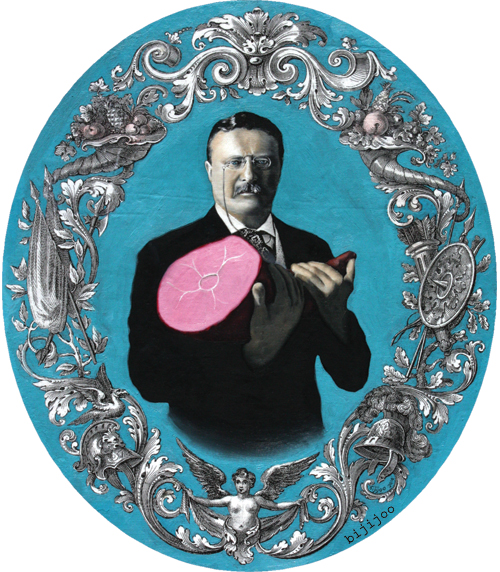
![]()
26th PRESIDENT
NAME: Theodore Roosevelt, Jr. He was named after his father. The toy teddy bear was named for him after a cartoon depicted him sparing the life of a cub while hunting. Often referred to as TR in news headlines, he was the first president to be known popularly by his initials.
PHYSICAL DESCRIPTION: Spindly, pale, asthmatic as a boy, Roosevelt, through rigorous exercise and sheer force of will, matured into a brawny, robust man of action. He stood about 5 feet 8 inches tall, weighed about 200 pounds, and had a great barrel chest, bull neck, cleft chin, closely cropped brown hair, wide-set blue eyes, a bushy drooping mustache, a rather large nose, and small ears and feet. His most distinctive feature was a wide toothsome grin. He spoke in a rather high-pitched voice. He wore pince-nez to correct severe myopia. As president he suffered a hard blow to his left eye during a boxing match; he developed a detached retina and lost virtually all vision in that eye. Roosevelt characteristically stood with his shoulders back and his head pitched slightly forward. He dressed fashionably.
PERSONALITY: It was often said that Roosevelt craved the limelight, that he set at to be, as one observer put it, “the bride at every wedding, the corpse at every funeral.” The youngest man to become president, he was also the most visibly energetic, zestful chief executive up to that time. Unlike many of his predecessors, he delighted in being president and was sorry to see his term end. He was fearless, decisive, ambitious, proud, and irresistibly charming to men and women alike. He loved children and often took the time to romp with them or gather round them for a story. A gifted raconteur, he captivated listeners with tales of his adventures out West. He detested dirty jokes, however, and typically walked away in the middle of a story as soon as he detected its off-color nature. Whether delivering speeches before large crowds or engaged in a private conversation, Roosevelt spoke forcefully in crisp, clipped tones and gesticulated constantly, his fist pounding the air to emphasize a point, his head jerking to and fro with each word. But he was also a good listener, capable of remaining stock still for extended periods totally engrossed in the words of others. He had a prodigious, apparently photographic memory. He often stunned visitors by reciting whole passages of a book he had read decades before. He explained that with concentration the page seemed to appear in his mind’s eye and he simply read from it.
PRIMARY SOURCE: DeGregorio, William A. The Complete Book of U.S. Presidents. 7th ed. Fort Lee: Barricade Books, 2009.

 Brought to you by
Brought to you by 
